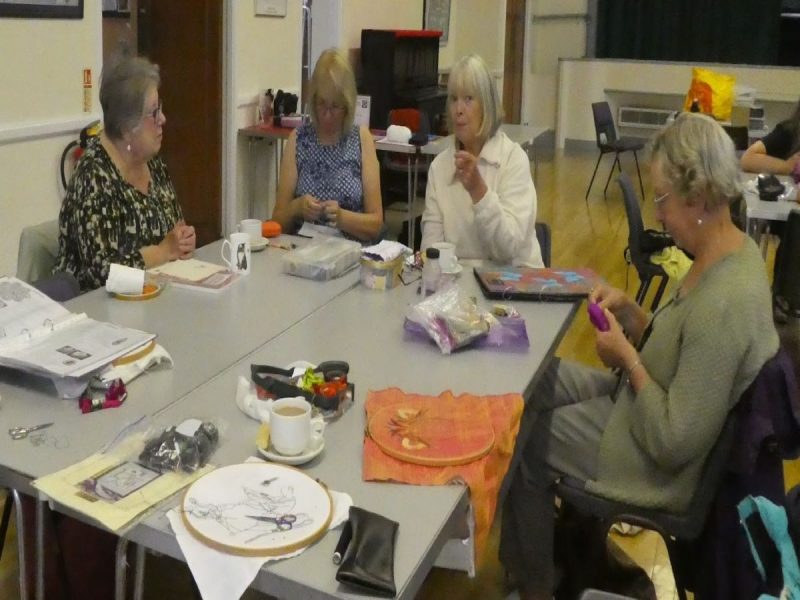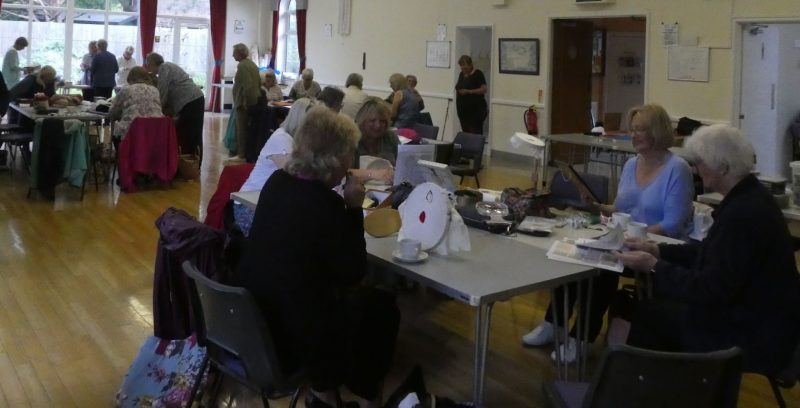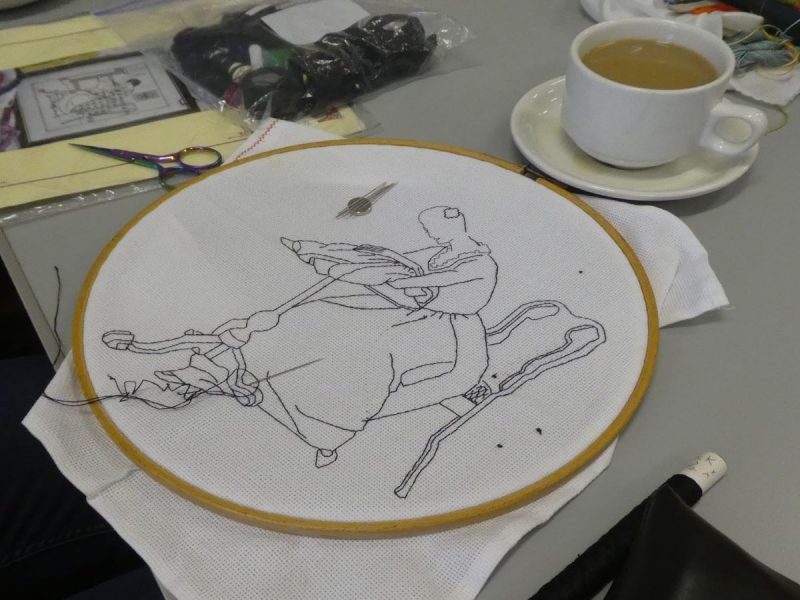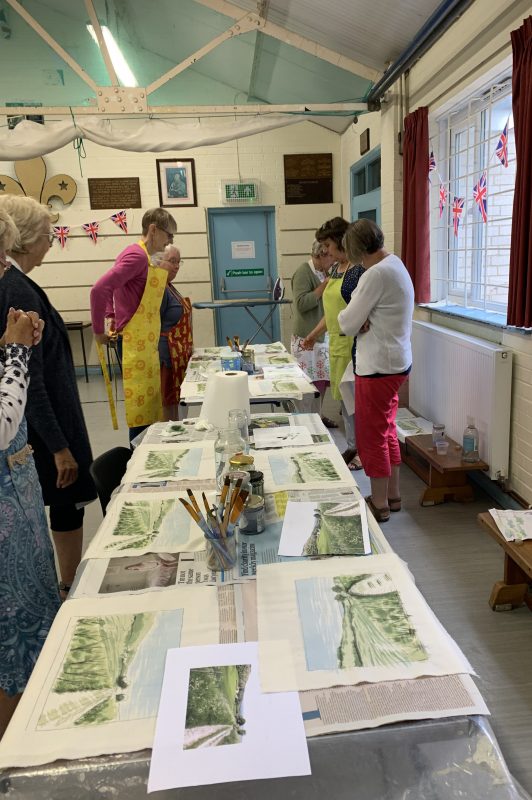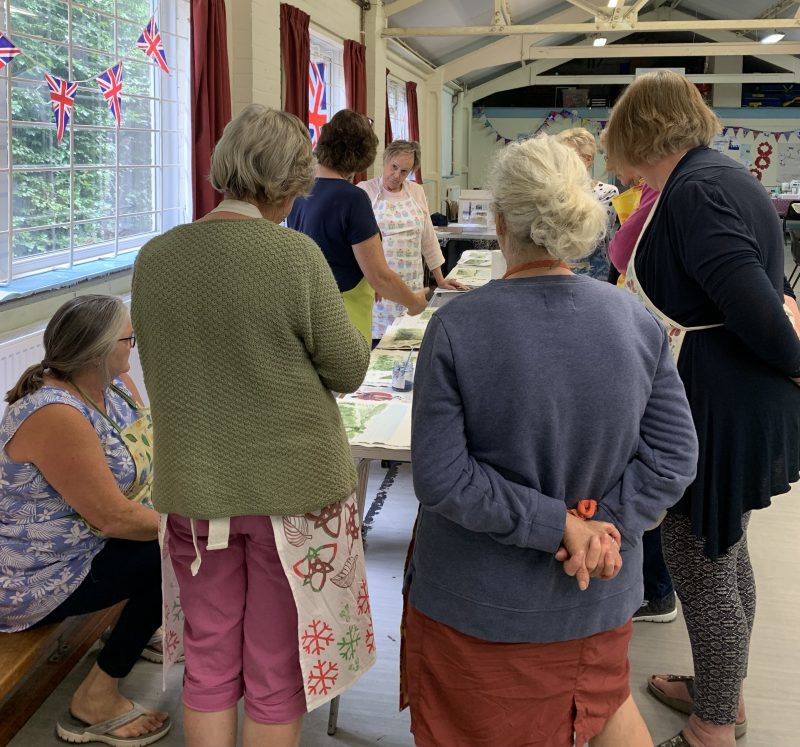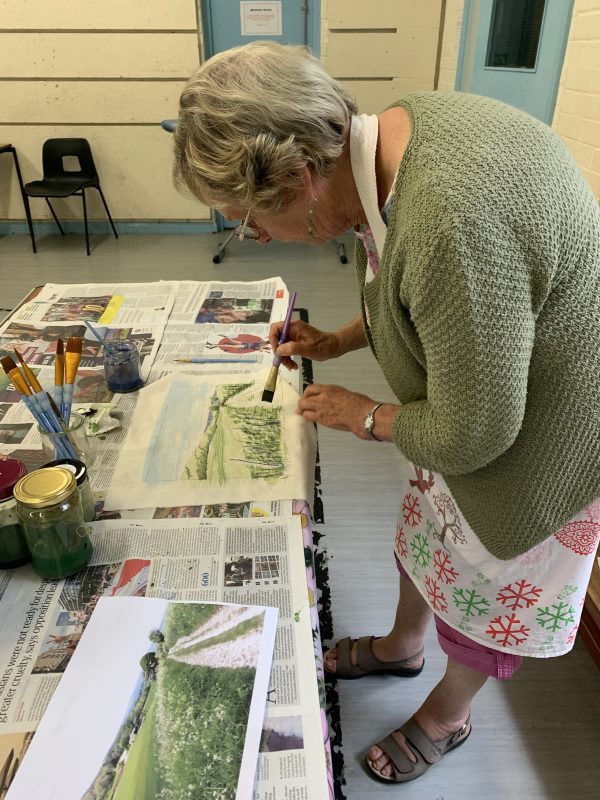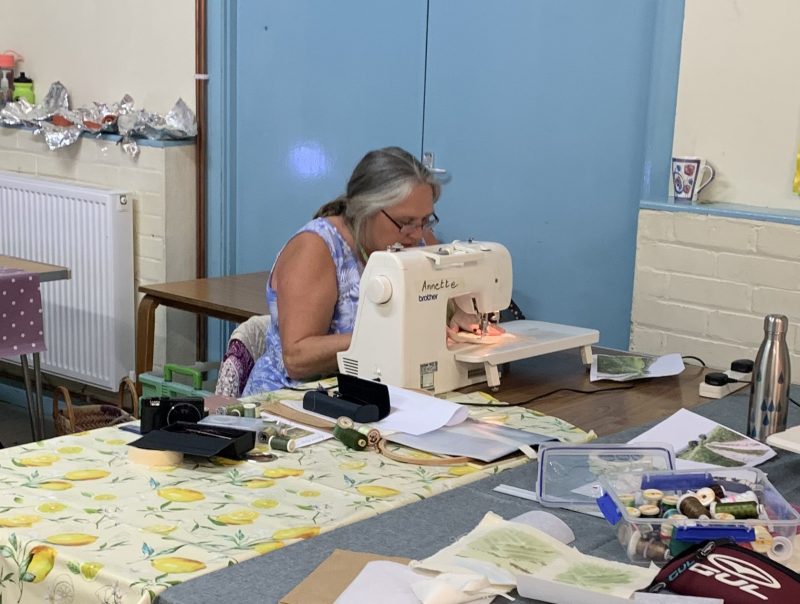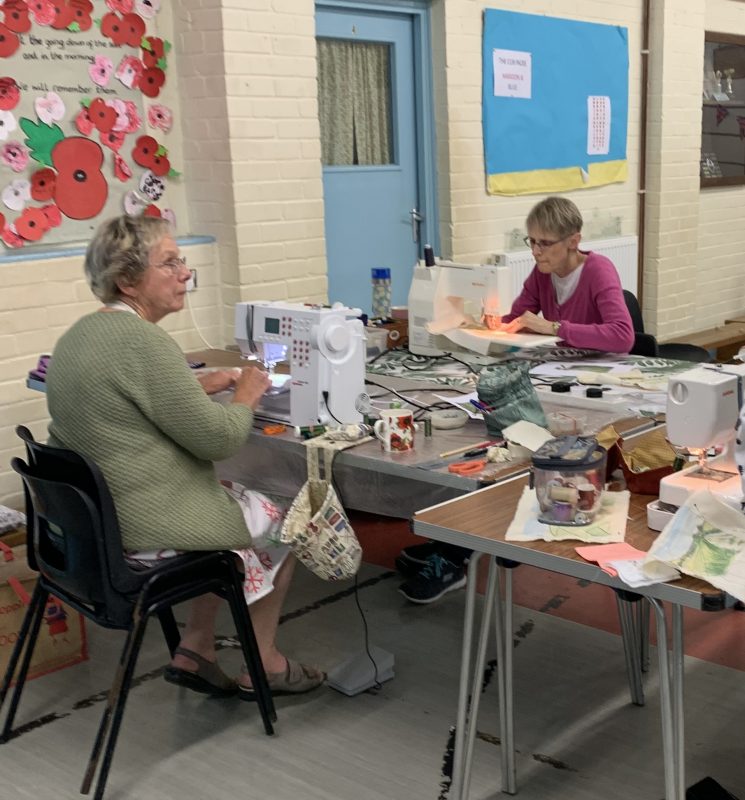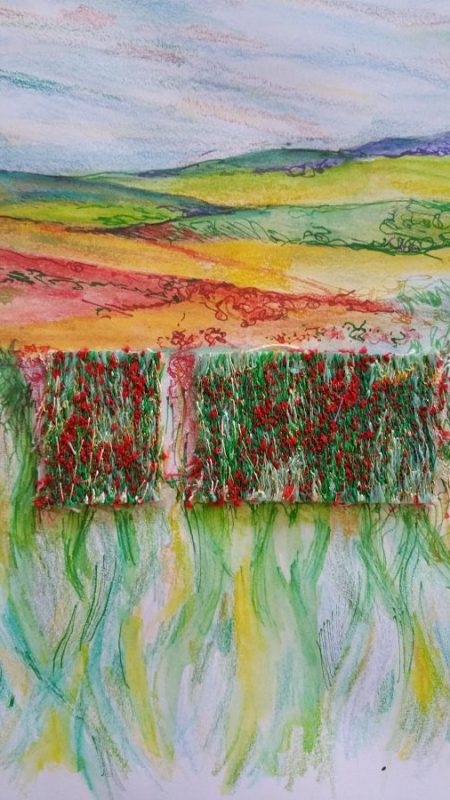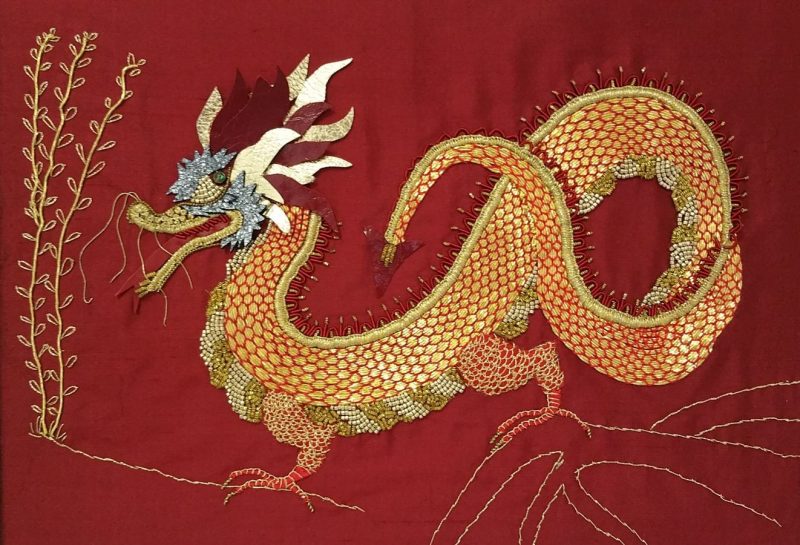 At our October meeting we were treated to an unexpected talk by member Daphne Dedman. Our booked speaker was unable to attend (she will come in 2023 instead). Instead, Daphne kindly gave us a talk about her work: firstly, the work she has done on repairing and restoring Masonic banners and then on her own work. Banner restoration started with volunteering to repair the banner for Worthing, and it gradually snowballed until 10 years later she has become rather an expert. Daphne explained how she preserves as much of the original work as possible, only replacing some areas if they are beyond repair. The work encompasses goldwork, silk shading, applique, fabric painting and much more. Sadly I am not able to show any of the banners here, because we don’t have permission from the Masons to show them. However, the second half of Daphne’s talk was about her own work, and she brought some lovely examples to show us. We were all impressed with the range and quality of Daphne’s work. Isn’t it good to see someone’s work all laid out together for people to enjoy. Scroll down below to see some examples of Daphne’s work.
At our October meeting we were treated to an unexpected talk by member Daphne Dedman. Our booked speaker was unable to attend (she will come in 2023 instead). Instead, Daphne kindly gave us a talk about her work: firstly, the work she has done on repairing and restoring Masonic banners and then on her own work. Banner restoration started with volunteering to repair the banner for Worthing, and it gradually snowballed until 10 years later she has become rather an expert. Daphne explained how she preserves as much of the original work as possible, only replacing some areas if they are beyond repair. The work encompasses goldwork, silk shading, applique, fabric painting and much more. Sadly I am not able to show any of the banners here, because we don’t have permission from the Masons to show them. However, the second half of Daphne’s talk was about her own work, and she brought some lovely examples to show us. We were all impressed with the range and quality of Daphne’s work. Isn’t it good to see someone’s work all laid out together for people to enjoy. Scroll down below to see some examples of Daphne’s work.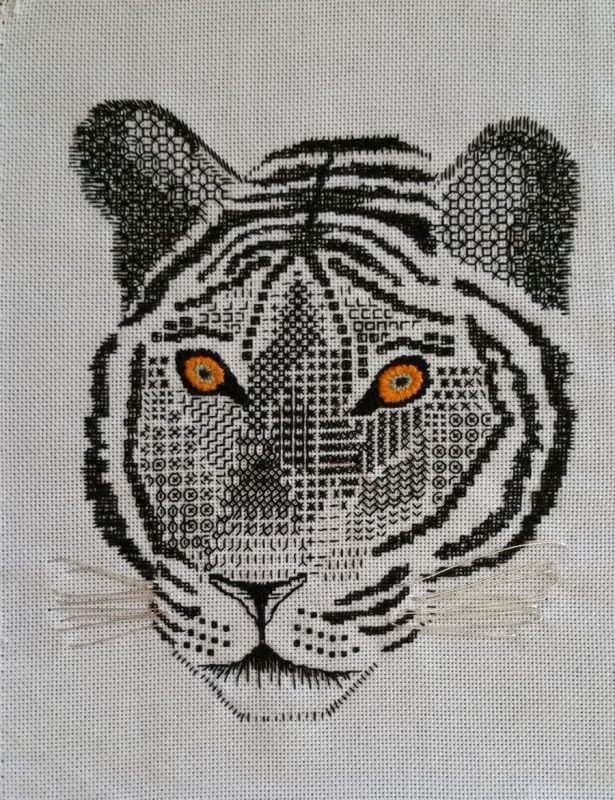
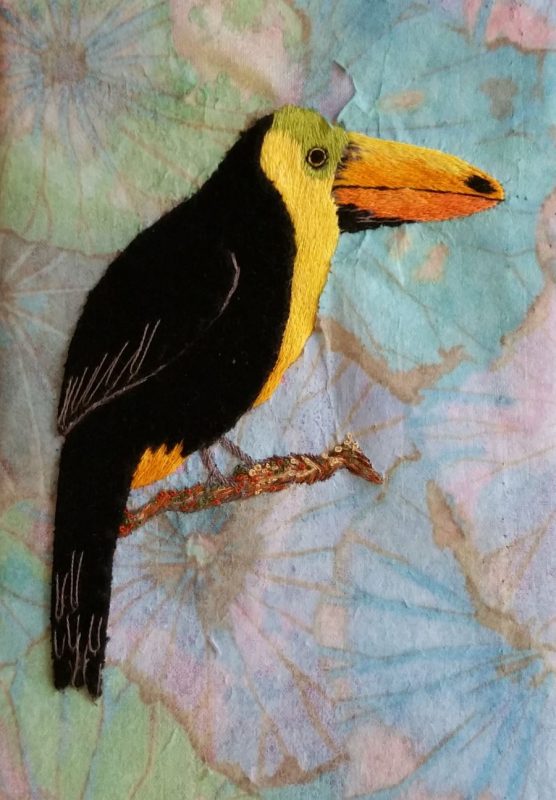
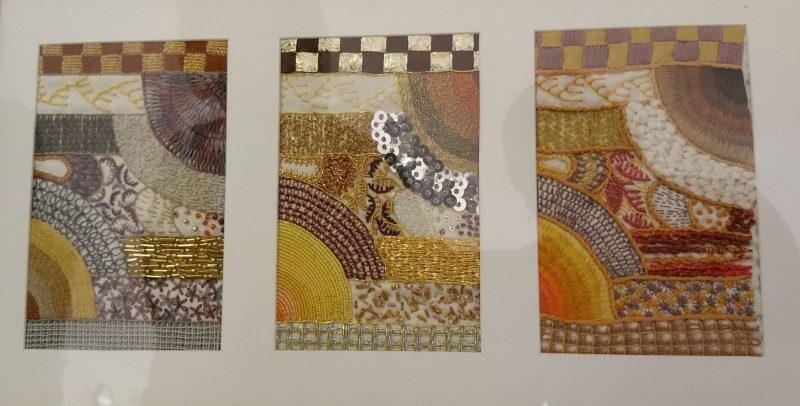
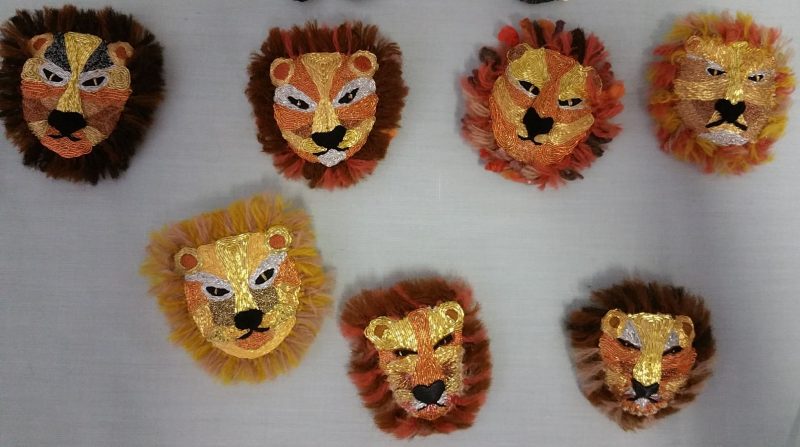
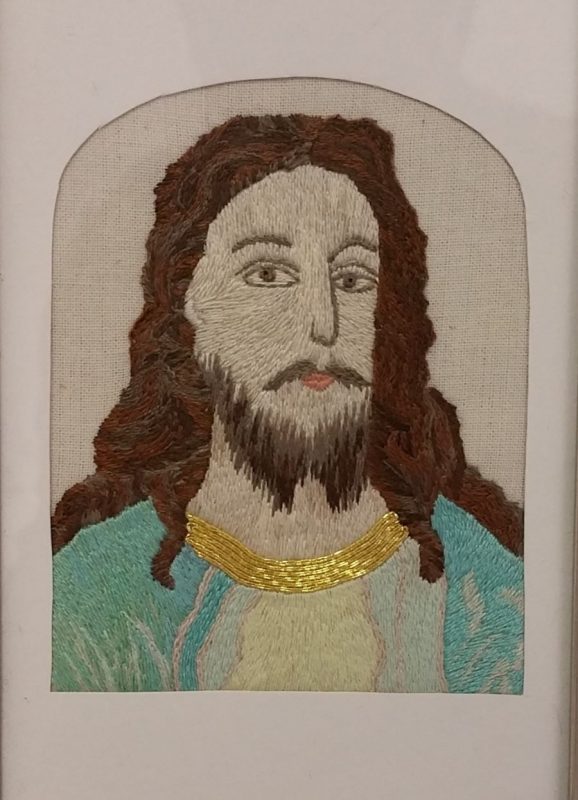
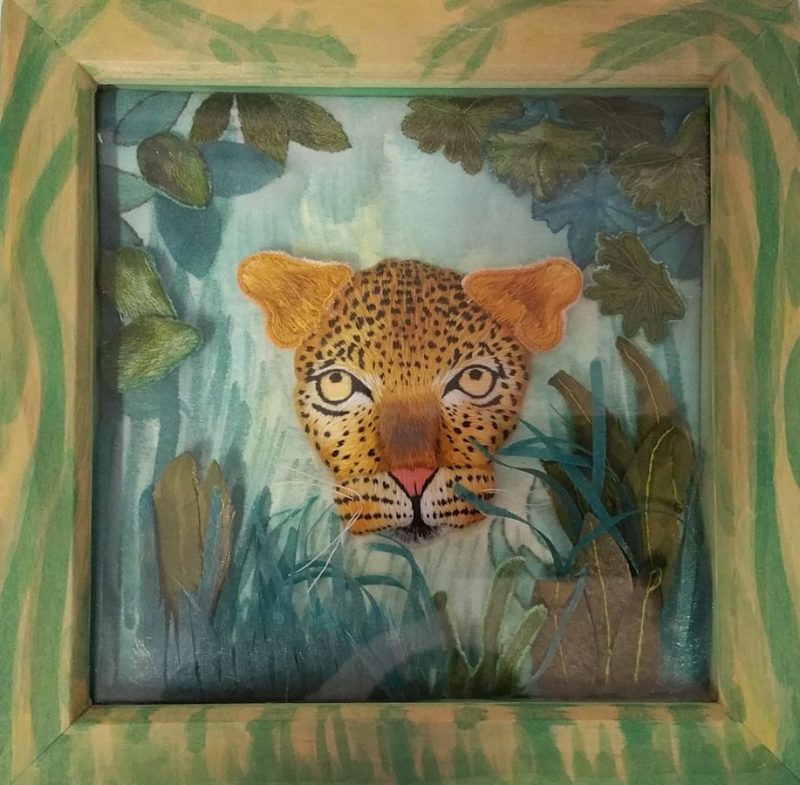
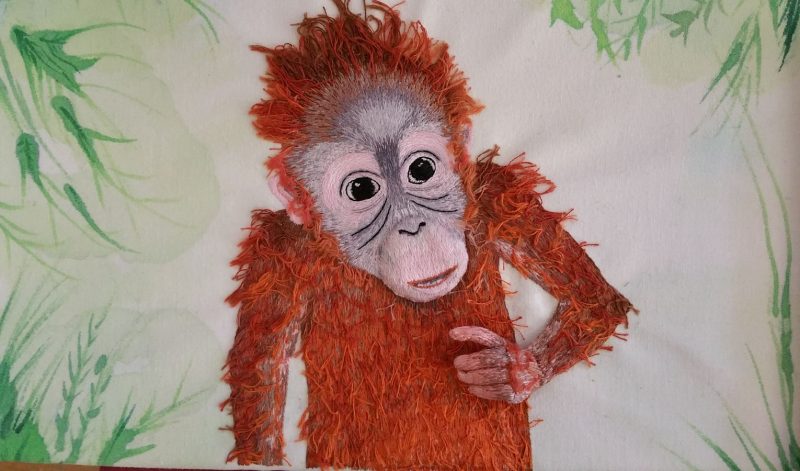
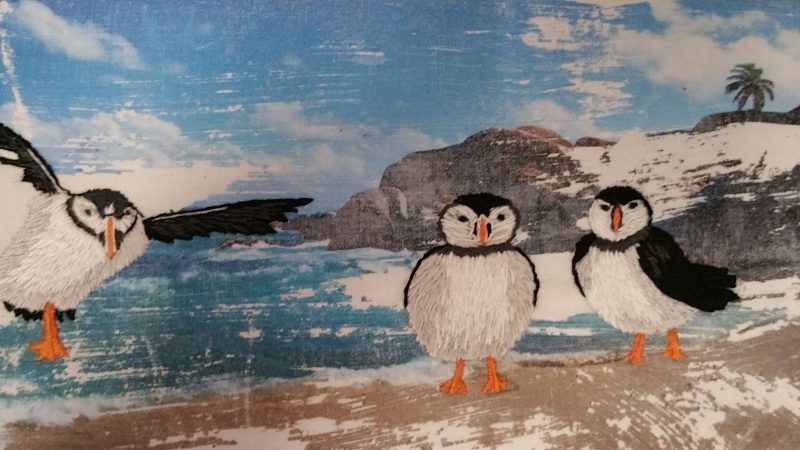
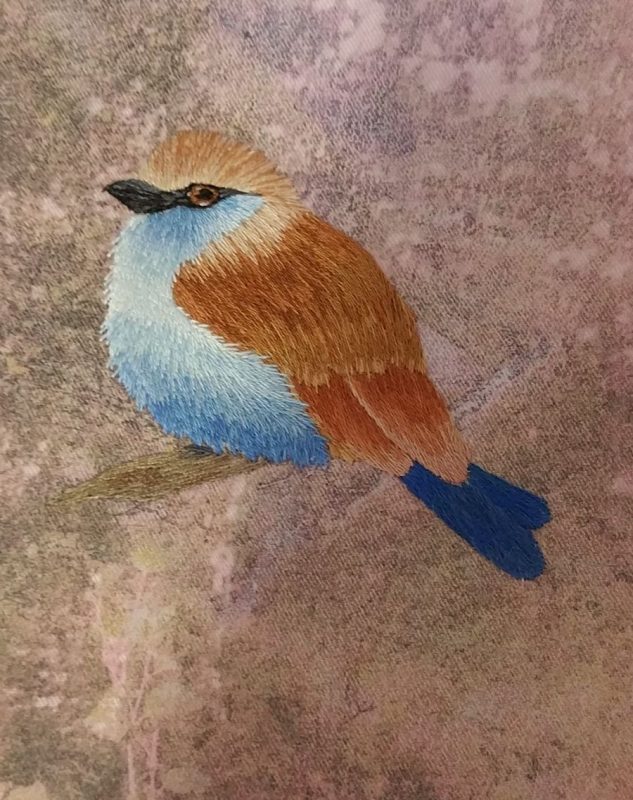
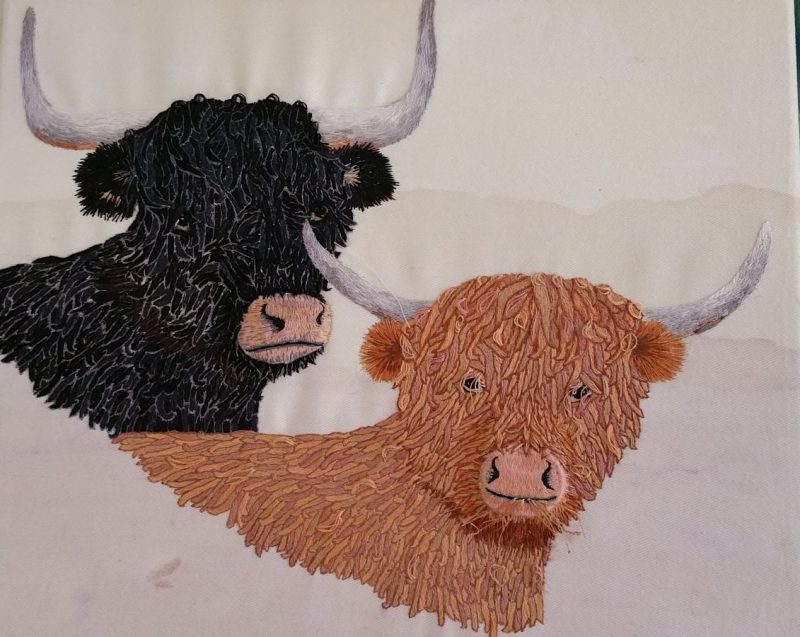
Author: Jane
Last month’s meeting
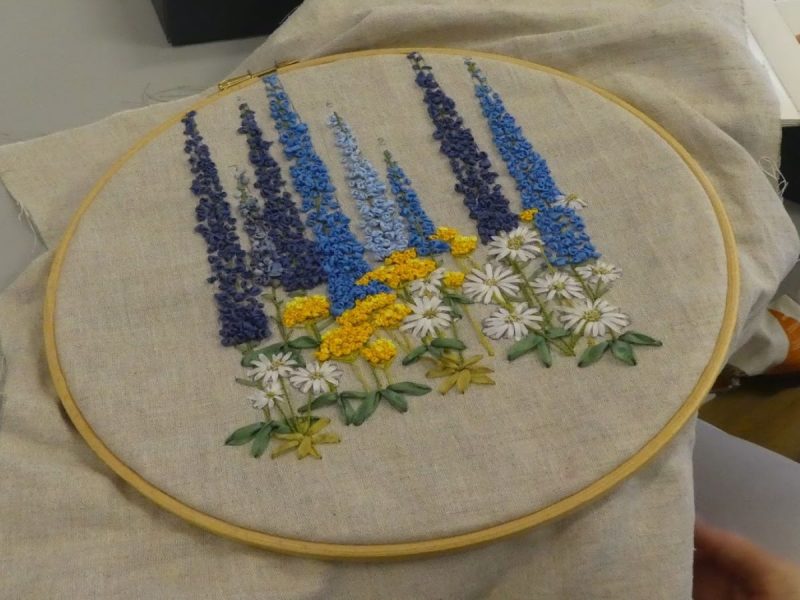 Thanks to Annette for sending in some photos from the September ‘sit-and-sew’. They are a bit late appearing on here as I’ve been away. I was sorry to miss the meeting, but judging by the photos it looks like a good afternoon. The photos of individual work have’t got names on them; if you would like to claim one as yours, just put a comment in the box below here and I’ll add your name.
Thanks to Annette for sending in some photos from the September ‘sit-and-sew’. They are a bit late appearing on here as I’ve been away. I was sorry to miss the meeting, but judging by the photos it looks like a good afternoon. The photos of individual work have’t got names on them; if you would like to claim one as yours, just put a comment in the box below here and I’ll add your name.
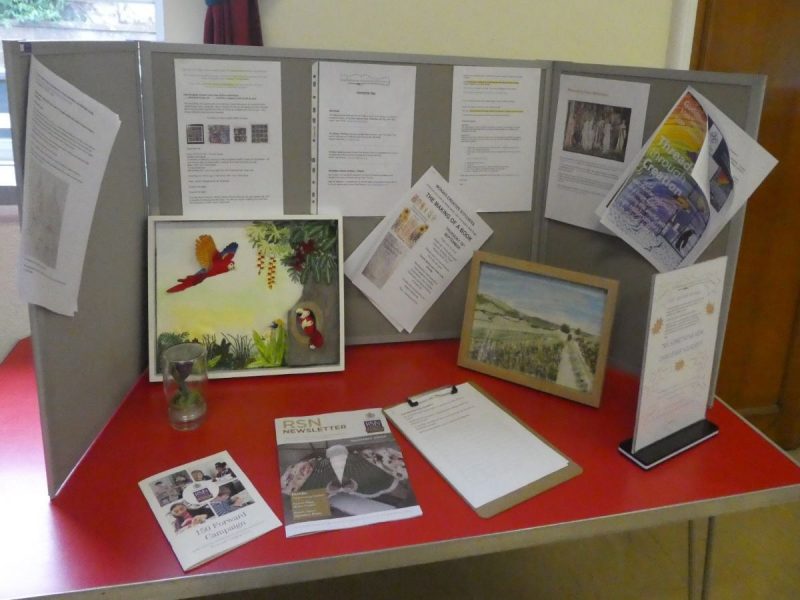
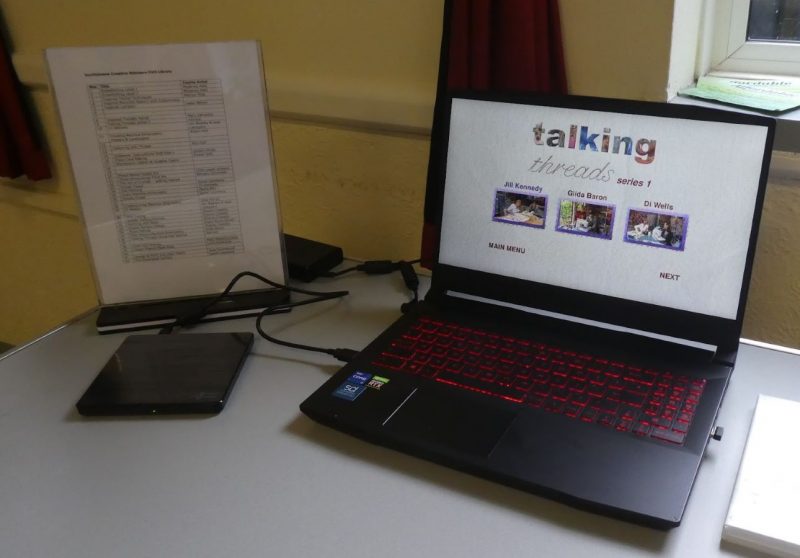
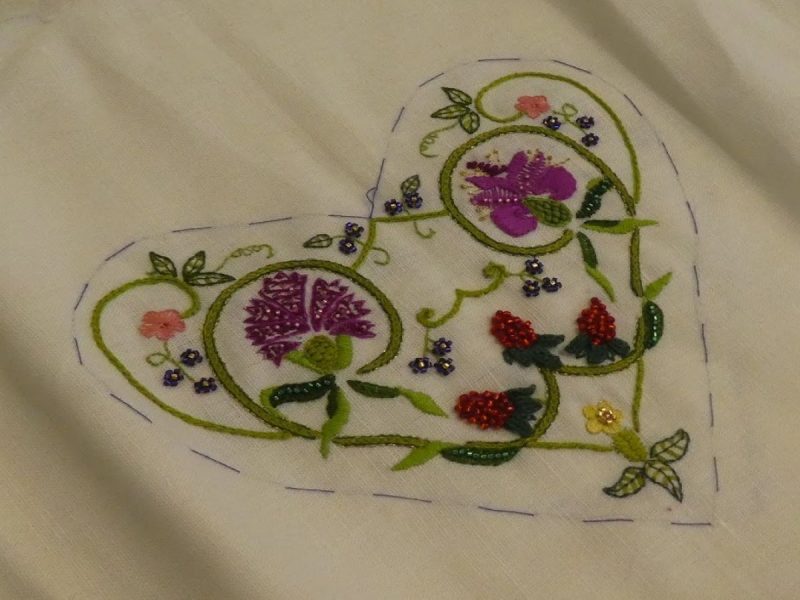
‘I will remember him’.
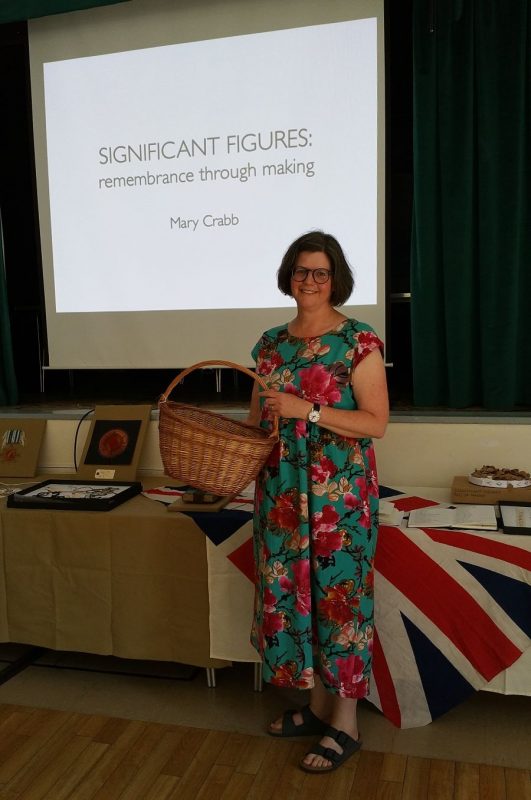 Mary Crabb gave an interesting and thought-provoking talk at our August meeting, called ‘Significant Figures’. As well as appealing to embroidery/textiles enthusiasts, this was a moving talk that reflected the themes of loss and remembrance. Mary is a weaver and basket-maker, who was inspired to create a body of work to honour her grandmother’s first love, Cecil, who died in France in 1915 very soon after lying about his age in order to enlist.
Mary Crabb gave an interesting and thought-provoking talk at our August meeting, called ‘Significant Figures’. As well as appealing to embroidery/textiles enthusiasts, this was a moving talk that reflected the themes of loss and remembrance. Mary is a weaver and basket-maker, who was inspired to create a body of work to honour her grandmother’s first love, Cecil, who died in France in 1915 very soon after lying about his age in order to enlist.
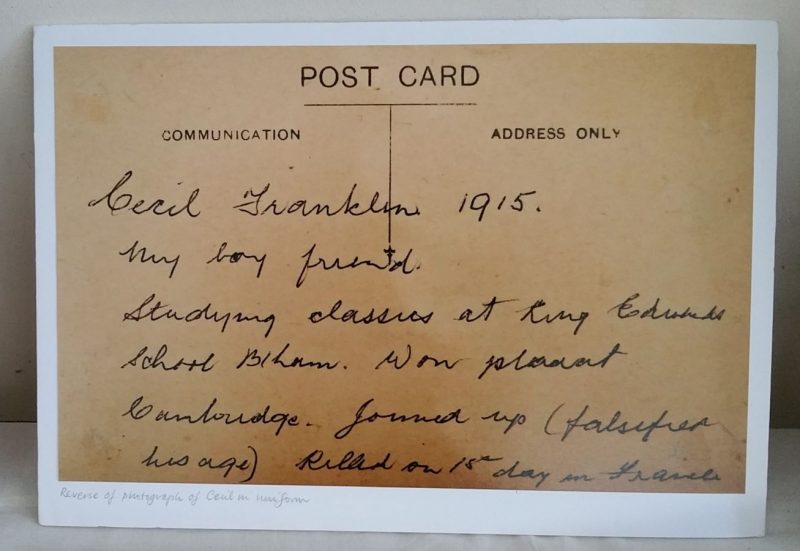 Despite an apparently happy marriage later on, Mary’s grandmother always remembered her first love, Cecil, referring to him as ‘my Cecil’. She kept a postcard on her mantlepiece, with Cecil’s photograph on one side and some brief notes on his life on the other side. Mary’s work became a mission to honour Cecil’s life and to understand the way her grandmother kept his memory alive. Part of Mary’s journey involved visiting places associated with Cecil; for example on the 100th anniversary of his death Mary visited the beautiful cemetery in France where he was buried, where she placed a posy in his grave.
Despite an apparently happy marriage later on, Mary’s grandmother always remembered her first love, Cecil, referring to him as ‘my Cecil’. She kept a postcard on her mantlepiece, with Cecil’s photograph on one side and some brief notes on his life on the other side. Mary’s work became a mission to honour Cecil’s life and to understand the way her grandmother kept his memory alive. Part of Mary’s journey involved visiting places associated with Cecil; for example on the 100th anniversary of his death Mary visited the beautiful cemetery in France where he was buried, where she placed a posy in his grave.
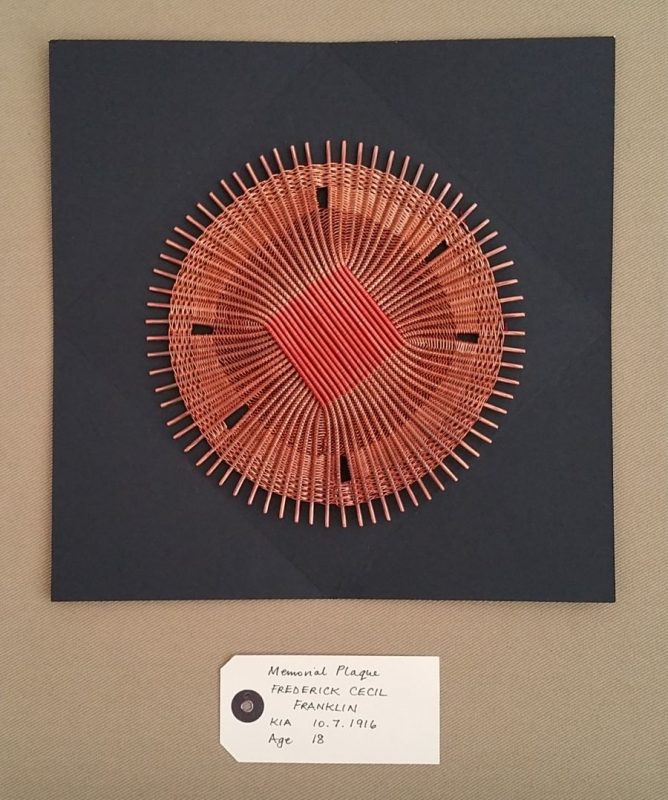 Mary decided to create a memorial plaque for Cecil, using her twining skills. This was created in copper, and the design is a mathematical creation based on the number 18, due to the 18 years of Cecil’s life.
Mary decided to create a memorial plaque for Cecil, using her twining skills. This was created in copper, and the design is a mathematical creation based on the number 18, due to the 18 years of Cecil’s life.
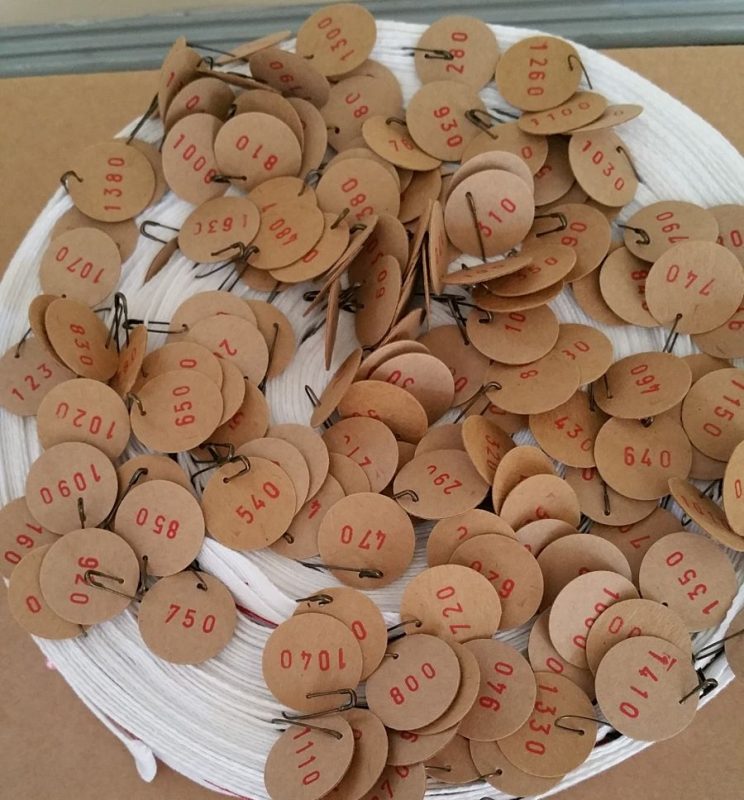 Mary visited Cecil’s school, where she was shown a roll of honour of all the old boys of the school who had gone to war, and she learned that 255 did not return. This inspired a new piece of work, a reflection on the real cost of war in the loss of young life. Mary’s mathematical mind came to the fore in this project: she created a very long line of stitched white tape, on which she embroidered lines (like a school register) with an ‘up’ arrow for those who went to war, and a ‘down’ arrow for those who didn’t come back. Each boy had a number in the book, and for each one who didn’t come back Mary made a ‘dog tag’ that she attached to the tape. Each tag represents a young man from the school who didn’t return. Cecil is number 481.
Mary visited Cecil’s school, where she was shown a roll of honour of all the old boys of the school who had gone to war, and she learned that 255 did not return. This inspired a new piece of work, a reflection on the real cost of war in the loss of young life. Mary’s mathematical mind came to the fore in this project: she created a very long line of stitched white tape, on which she embroidered lines (like a school register) with an ‘up’ arrow for those who went to war, and a ‘down’ arrow for those who didn’t come back. Each boy had a number in the book, and for each one who didn’t come back Mary made a ‘dog tag’ that she attached to the tape. Each tag represents a young man from the school who didn’t return. Cecil is number 481.
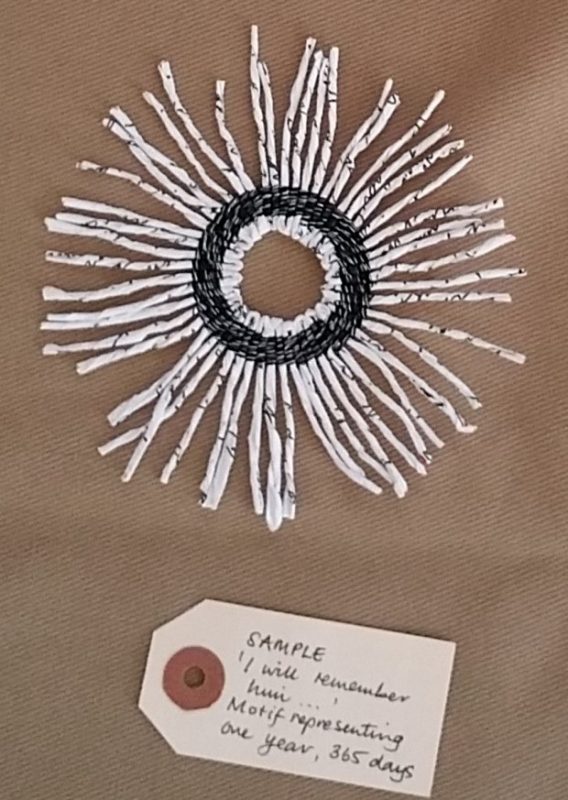 Mary was always very moved by her grandmother’s love and loyalty. She created a piece of work that reflects this. She painstakingly wrote the text of her grandmother’s postcard onto white paper, time and time again, then twisted them and made them into many individual medallions. Each medallion represented all the days in each of the years in which her grandmother had remembered Cecil; presented together on a large wall, they represented the decades. You can see a photo of the whole installation on Mary’s website.
Mary was always very moved by her grandmother’s love and loyalty. She created a piece of work that reflects this. She painstakingly wrote the text of her grandmother’s postcard onto white paper, time and time again, then twisted them and made them into many individual medallions. Each medallion represented all the days in each of the years in which her grandmother had remembered Cecil; presented together on a large wall, they represented the decades. You can see a photo of the whole installation on Mary’s website.
Judging by the intelligent mathematical question asked by someone behind me in the audience (you know who you are!) other people had a better grasp of the mathematical concepts behind Mary’s work than I did. However, Mary’s talk appealed on very different levels, including the intricacy of her work and the historical context. It was fascinating to hear about the way her grandmother honoured Cecil’s memory for so many years. It was interesting to hear how such a big body of work can be inspired by one idea, in this case the lifelong remembrance of a lost love. To see more of Mary’s work, and the courses that she offers, go to https://www.crabbbaskets.com/
Sussex landscapes in machine embroidery
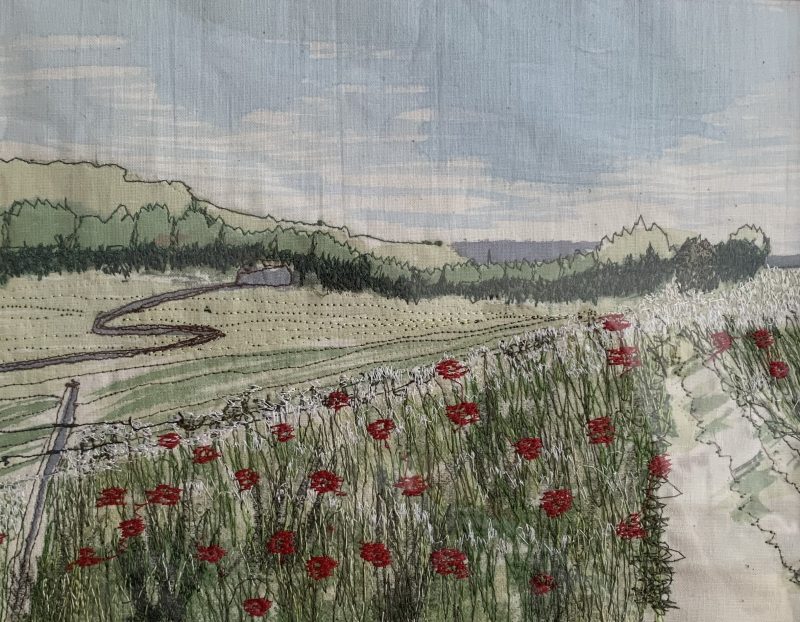
I’ve received some lovely photos from the workshop in June with Julia Brown, on Sussex landscapes in machine embroidery (thanks to Margaret for the photos). I’ve seen some wonderful creations from this day, and everyone seems to have really enjoyed it. Julia showed people how to colour the fabric ready for stitching, and while that dried she demonstrated some useful tips on machine embroidery. Julia gave everyone a pre-prepared canvas to practice stitching on while their canvas dried, and while they learned the techniques. The bigger painted canvas was taken away to complete at home. The two shown here are by Margaret, and there are also some photos of the workshop in progress. You can see the concentration!
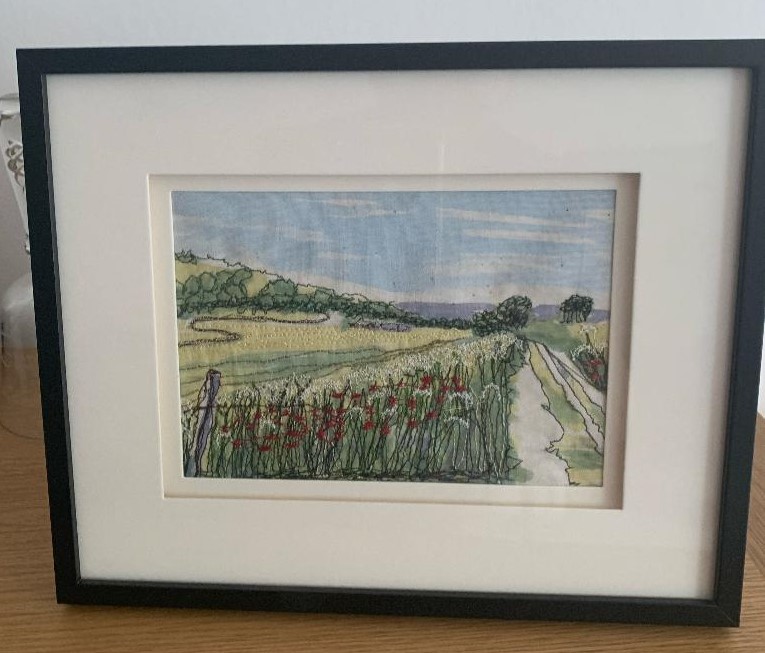
Kim Thittichai says ‘come and play with me’.
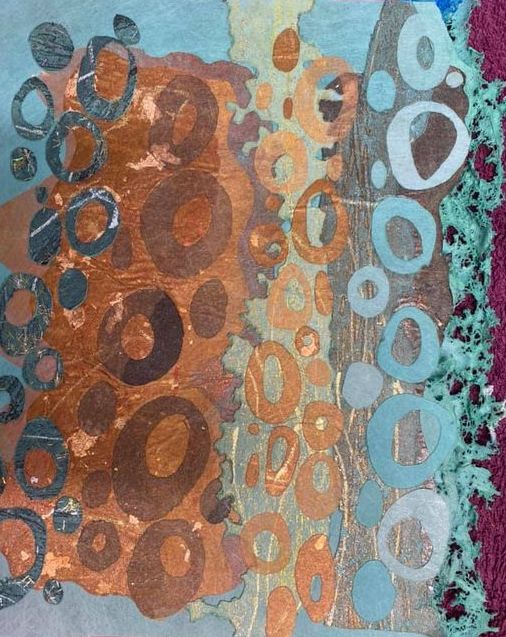 Many of our members need no introduction to Kim Thittichai, the well-known international textile artist who lived in Sussex until a few years ago. Many of us have benefited from her inspiring teaching over the years (I was very fortunate to do a year-long City and Guilds Textile Decoration course with her many moons ago, and I’m still using and enjoying techniques that I learnt from that course). Kim made an inspiring move to the South West coast of Ireland a few years ago, where she is pursuing her own textile work as well as teaching online. That brings me to the reason for this post: Kim is now offering her ‘signature’ Experimental Textiles course online. If you feel ready to take on the fun and challenge of a bigger course, there is more information in the link below. It’s a 10-month course with monthly online tuition sessions, monthly individual tutorial, monthly project, an online support group with other course members, and two years access to the 24 videos that make up the content of the course. Kim recognises that it’s a big commitment, so if you’re interested, she suggests you contact her to talk it over before deciding. Have a look at her website and you’ll see lots of inspiring images. If you’re ready for a new challenge, do consider it. I can guarantee you’ll have fun! https://www.kimthittichai.com/?utm_source=Sonas+Studio+reminder+list&utm_campaign=ba0785c435-EMAIL_CAMPAIGN_2022_07_27_07_05&utm_medium=email&utm_term=0_428c83cced-ba0785c435-334865653
Many of our members need no introduction to Kim Thittichai, the well-known international textile artist who lived in Sussex until a few years ago. Many of us have benefited from her inspiring teaching over the years (I was very fortunate to do a year-long City and Guilds Textile Decoration course with her many moons ago, and I’m still using and enjoying techniques that I learnt from that course). Kim made an inspiring move to the South West coast of Ireland a few years ago, where she is pursuing her own textile work as well as teaching online. That brings me to the reason for this post: Kim is now offering her ‘signature’ Experimental Textiles course online. If you feel ready to take on the fun and challenge of a bigger course, there is more information in the link below. It’s a 10-month course with monthly online tuition sessions, monthly individual tutorial, monthly project, an online support group with other course members, and two years access to the 24 videos that make up the content of the course. Kim recognises that it’s a big commitment, so if you’re interested, she suggests you contact her to talk it over before deciding. Have a look at her website and you’ll see lots of inspiring images. If you’re ready for a new challenge, do consider it. I can guarantee you’ll have fun! https://www.kimthittichai.com/?utm_source=Sonas+Studio+reminder+list&utm_campaign=ba0785c435-EMAIL_CAMPAIGN_2022_07_27_07_05&utm_medium=email&utm_term=0_428c83cced-ba0785c435-334865653
Picnic time
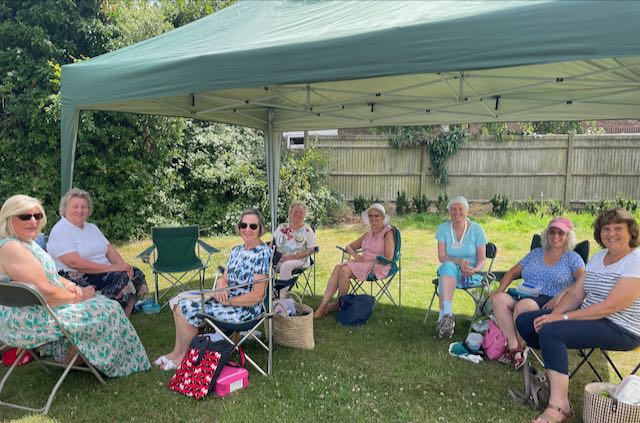 It doesn’t seem like a whole year ago that we were just cautiously coming out of lockdown. Our picnic this month was the anniversary of our first in-person get-together in July 2021. Formally the new SCS group started earlier in the year, but our first meeting with ‘real humans’ that summer rather than rectangular people on zoom felt like a new beginning, so this years picnic was a nice anniversary. Numbers were slightly depleted this month, due to holidays, Covid, and the extreme heat. However, those who attended had a good day, and managed to stay cool with the help of a collection of gazebos. Our stand-in David Bailey this month was Sue P, so thanks for the photos Sue.
It doesn’t seem like a whole year ago that we were just cautiously coming out of lockdown. Our picnic this month was the anniversary of our first in-person get-together in July 2021. Formally the new SCS group started earlier in the year, but our first meeting with ‘real humans’ that summer rather than rectangular people on zoom felt like a new beginning, so this years picnic was a nice anniversary. Numbers were slightly depleted this month, due to holidays, Covid, and the extreme heat. However, those who attended had a good day, and managed to stay cool with the help of a collection of gazebos. Our stand-in David Bailey this month was Sue P, so thanks for the photos Sue.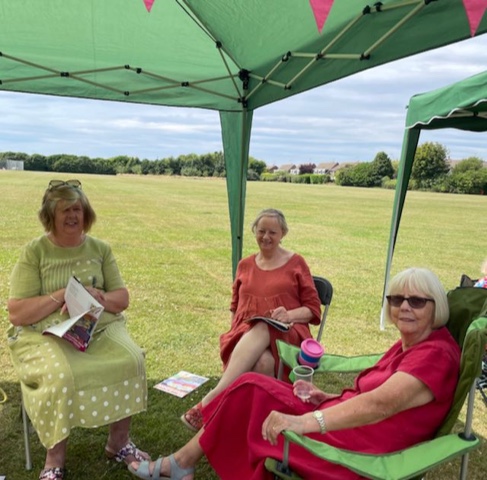
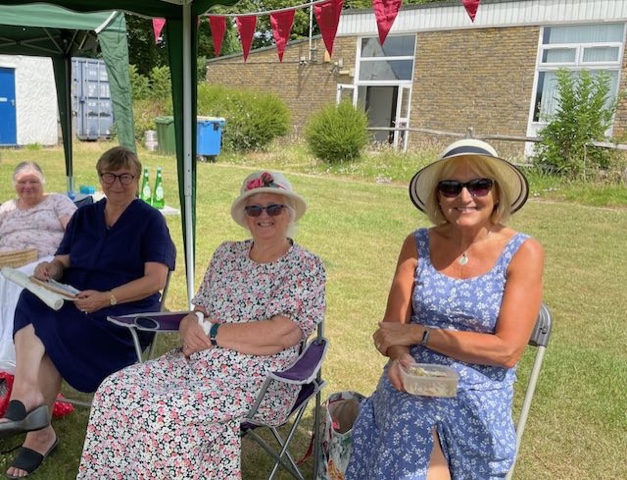
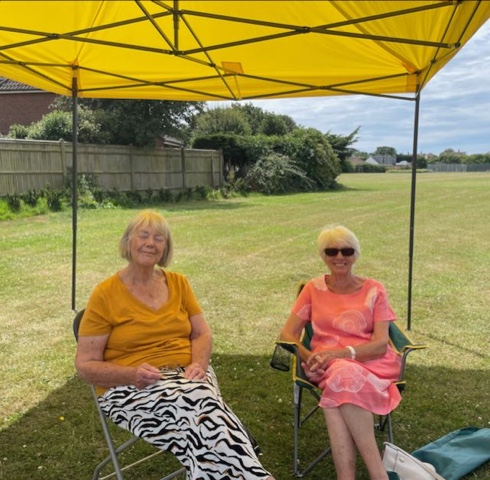
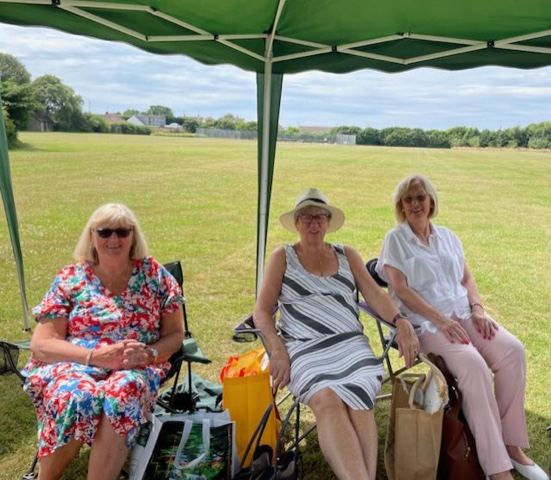
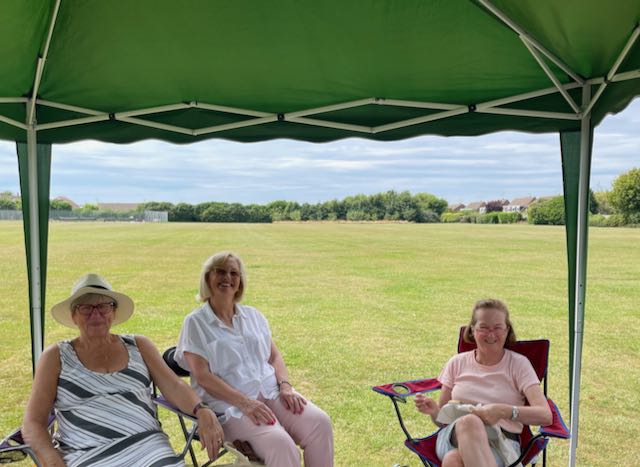
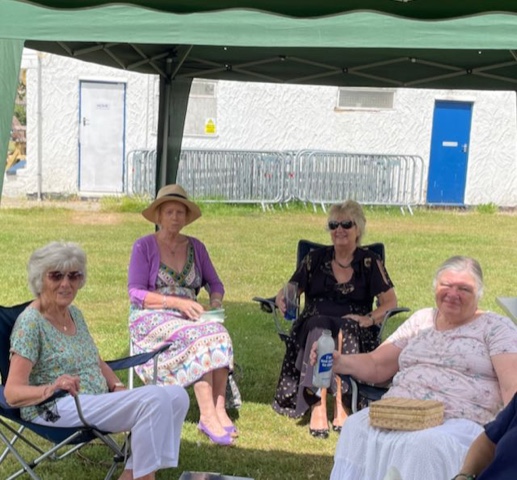
A passion for colour
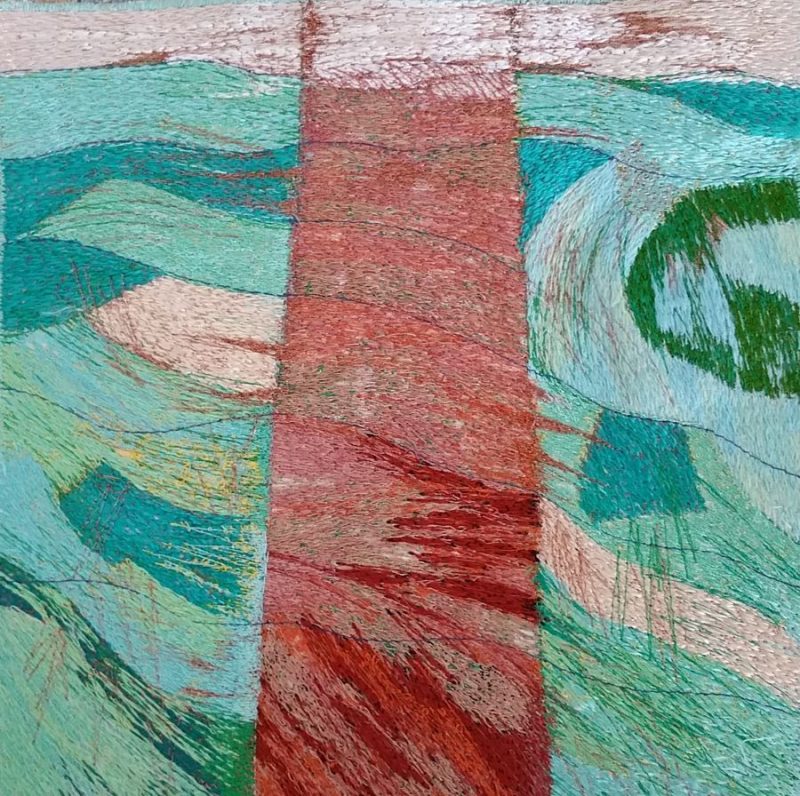 Carol Naylor was our inspiring speaker this month. Carol started by surprising us when she said that she was initially a ‘reluctant embroiderer’. She wanted to get into art college (Goldsmiths) to study painting, but was offered a place on the Goldsmiths embroidery course instead. People tried to talk her out of it. She accepted their misgivings (‘You can’t sew’, ‘You don’t like embroidery’) but she accepted the place, thinking that it would be ‘a foot in the door’ and that after a few weeks she would change to painting. Little did she know that embroidery would turn out to be a life-long passion.
Carol Naylor was our inspiring speaker this month. Carol started by surprising us when she said that she was initially a ‘reluctant embroiderer’. She wanted to get into art college (Goldsmiths) to study painting, but was offered a place on the Goldsmiths embroidery course instead. People tried to talk her out of it. She accepted their misgivings (‘You can’t sew’, ‘You don’t like embroidery’) but she accepted the place, thinking that it would be ‘a foot in the door’ and that after a few weeks she would change to painting. Little did she know that embroidery would turn out to be a life-long passion.
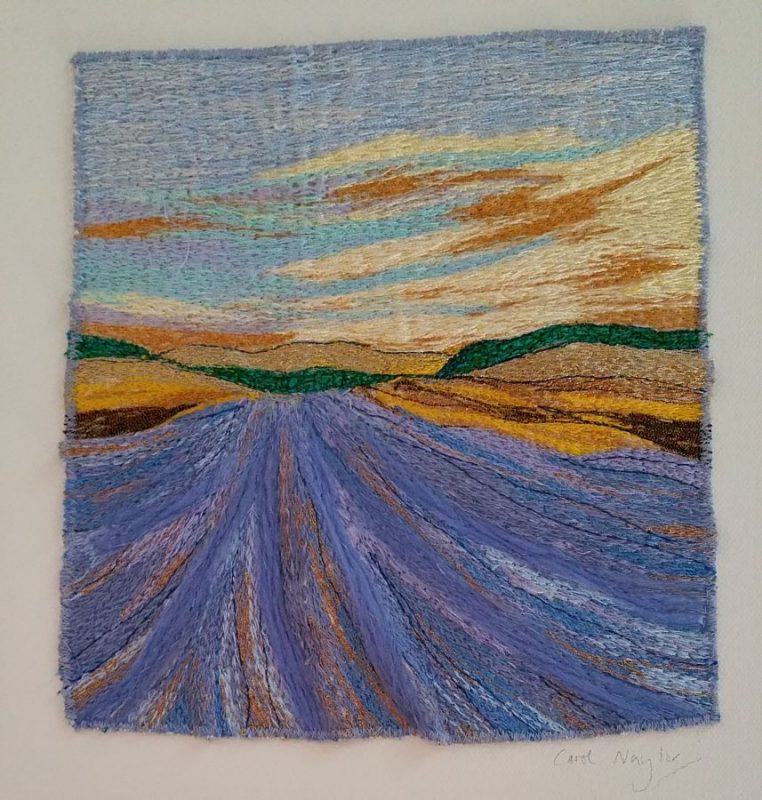 Somehow the change to painting never happened, and she found herself getting drawn into the world of stitch. Carol was lucky to be at Goldsmiths during the time when the legendary Constance Howard was teaching there. She spoke about her memories of Constance Howard’s green hair and her exacting standards. Carol struggled with embroidery for some time, but spoke about a breakthrough when Constance gave positive feedback on a small aspect of one of her pieces.
Somehow the change to painting never happened, and she found herself getting drawn into the world of stitch. Carol was lucky to be at Goldsmiths during the time when the legendary Constance Howard was teaching there. She spoke about her memories of Constance Howard’s green hair and her exacting standards. Carol struggled with embroidery for some time, but spoke about a breakthrough when Constance gave positive feedback on a small aspect of one of her pieces.
Carol’s interest in painting is self-evident in her work. From her post-graduate studies onwards, she developed her own style of ‘painting with the sewing machine’. She always creates from her own observations. She uses photos and sketchbooks as part of her preparation, but she finds it essential to have seen the subject directly. She brought sketchbooks for us to look at, and it was fascinating to see the development of a sketch, through stitch samples, and into a finished piece.
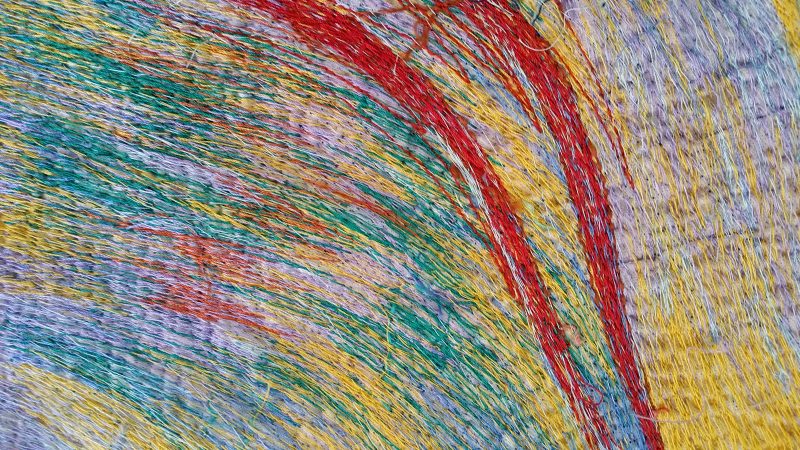
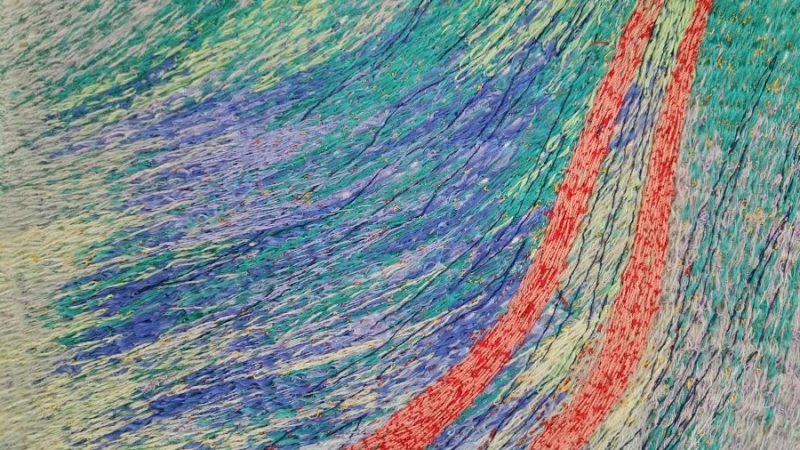 Carol works from the back of her work. The threads that she wants on the front of her work would be too thick to go through the needle, so she puts them in the bobbin and stitches ‘upside down’. The two photos above show the two sides of one of her pieces – interestingly, the back is also lovely!
Carol works from the back of her work. The threads that she wants on the front of her work would be too thick to go through the needle, so she puts them in the bobbin and stitches ‘upside down’. The two photos above show the two sides of one of her pieces – interestingly, the back is also lovely!
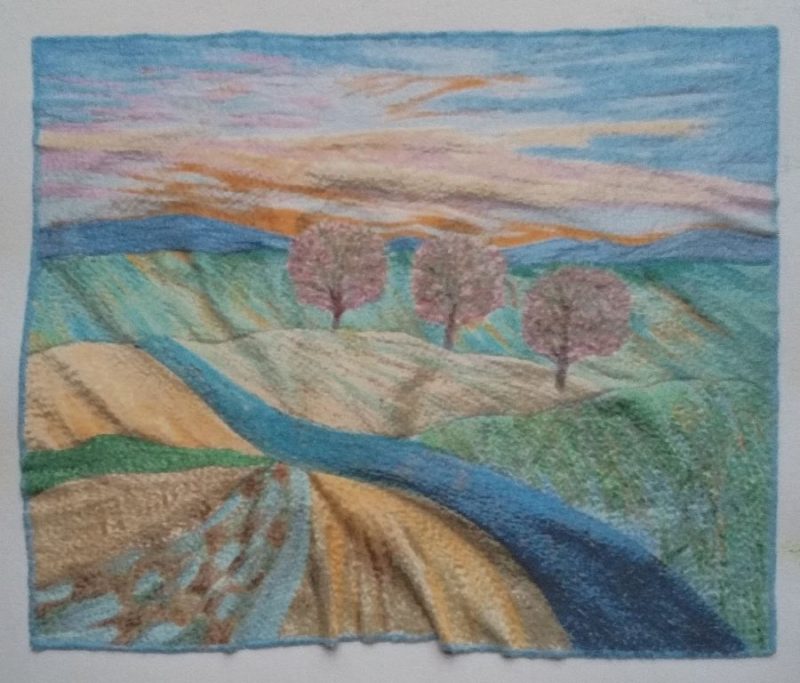 Carol ended up with a long-term career in textiles, becoming head of department at Chichester College for many years, interspersed with teaching Spanish. She eventually left the college to focus on her own work. She draws her inspiration from landscapes, with particular love of the South Downs, Italy and Spain.
Carol ended up with a long-term career in textiles, becoming head of department at Chichester College for many years, interspersed with teaching Spanish. She eventually left the college to focus on her own work. She draws her inspiration from landscapes, with particular love of the South Downs, Italy and Spain.
She spoke about how she loves to inspire other people, and also how she loves to see the work of other artists. She showed us some examples of work by other people that she admires, and talked about how different artistic disciplines can influence and inspire each other. Carol is a Fellow of the Society of Designer Craftsmen and was chairman for four years. She has work exhibited in the current exhibition at the Bankside Gallery (open now, until 26th June). She will also has work in a forthcoming exhibition at the Oxmarket Gallery in Chichester, as part of the local art group ARTEL. Each member of the group has submitted art inspired by the Chichester Ship Canal. Good timing, as the exhibition is open from Tues 21st June to Sun 3rd July, so I for one plan to go along to see it. Details in the link. https://www.oxmarket.org/exhibitions/artel-2022
Curious Threads
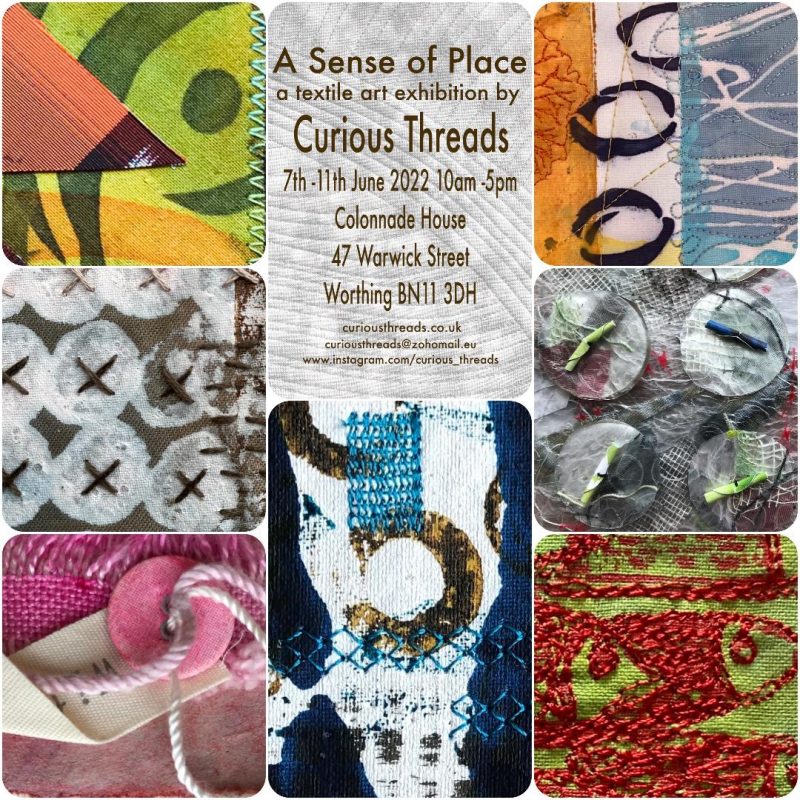 If you are free on Thursday, Friday or Saturday, I recommend this exhibition at Colonnade House (open from 10-5) by local textile group Curious Threads. Members of the group are Alison Livesley, Amelia Leigh, Jane Falls, Liz Howlett, Sue Duncan, Sue Sherwood and our very own Linda Hoddy. The group crosses the boundaries between quilting and embroidery; each member of the group produces a personal response to different ‘group challenges’. There’s some beautiful work there, as well as lovely bulging sketchbooks. It’s inspiring, and well worth a visit.
If you are free on Thursday, Friday or Saturday, I recommend this exhibition at Colonnade House (open from 10-5) by local textile group Curious Threads. Members of the group are Alison Livesley, Amelia Leigh, Jane Falls, Liz Howlett, Sue Duncan, Sue Sherwood and our very own Linda Hoddy. The group crosses the boundaries between quilting and embroidery; each member of the group produces a personal response to different ‘group challenges’. There’s some beautiful work there, as well as lovely bulging sketchbooks. It’s inspiring, and well worth a visit.

